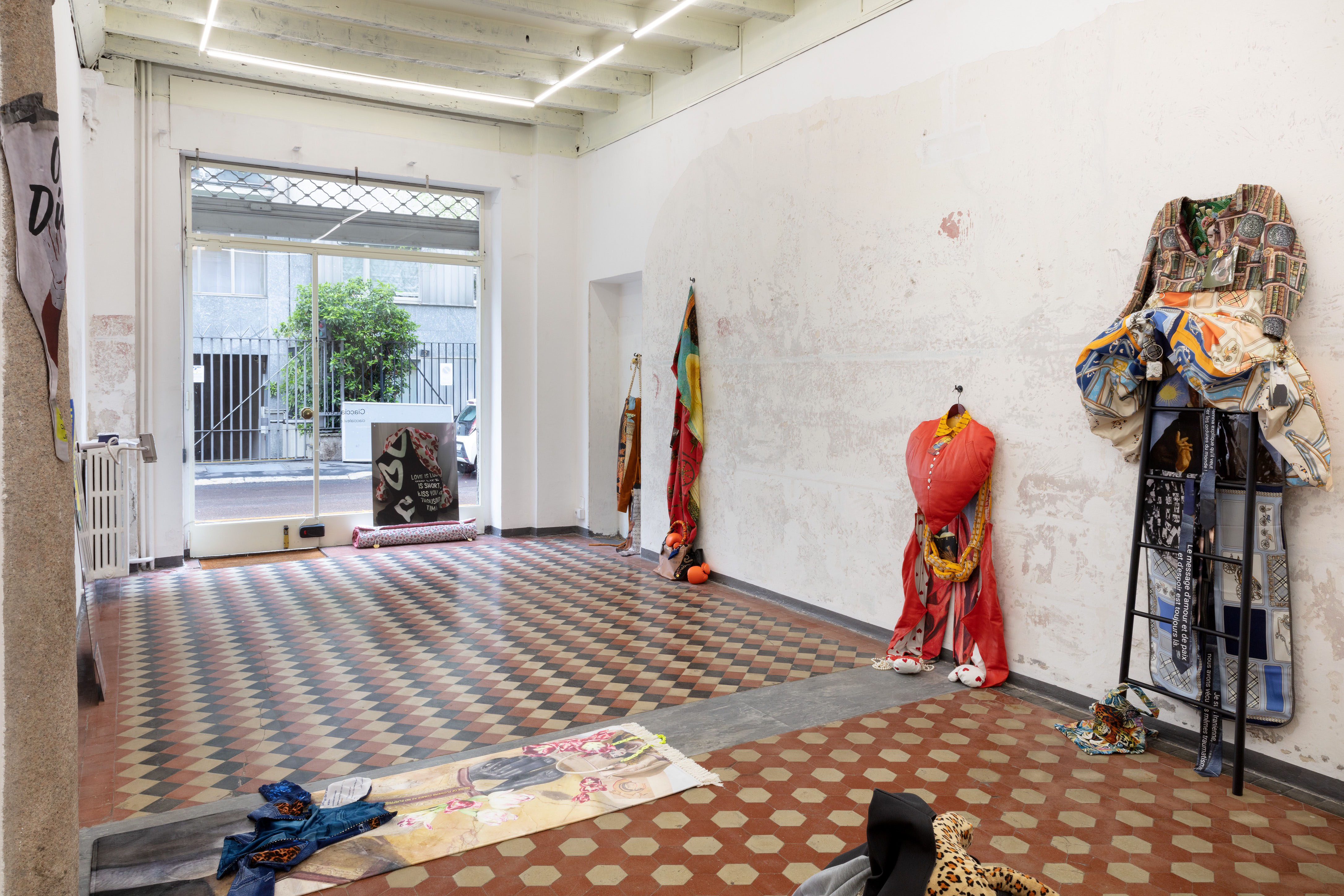Chalisée Naamani’s 21st Century Ghosts
A friend once told me about a visit to Ghana that I think about often. Across markets in West Africa’s second-biggest country, stalls sell obroni w’awu—“dead white men’s clothes” in Twi—from enormous bales that resemble giant, compressed Rubik’s cubes. These shrink-wrapped hand-me-downs come from the United States and Great Britain, where an insatiable hunger for newness sees 64.2 million USD worth of secondhand clothing discarded and sent to the shores of Ghana annually. At one such market stall, my friend picked up a shoe from a pile, turned it around, and read “TOPSHOP” on its sole. It was from only a few seasons ago, and it had most likely already traveled thousands of miles from its place of origin—probably in India, courtesy of Topshop’s Uttar Pradesh-based footwear manufacturer Tirubala Group, to somewhere in Britain, and then down and across the Atlantic Ocean to Accra. All in all, this pair of shoes would have traveled 7,615 air miles in its short life, generating over 405,000 pounds of carbon emissions; it was liked enough to have been purchased once but not loved enough to have been kept forever.
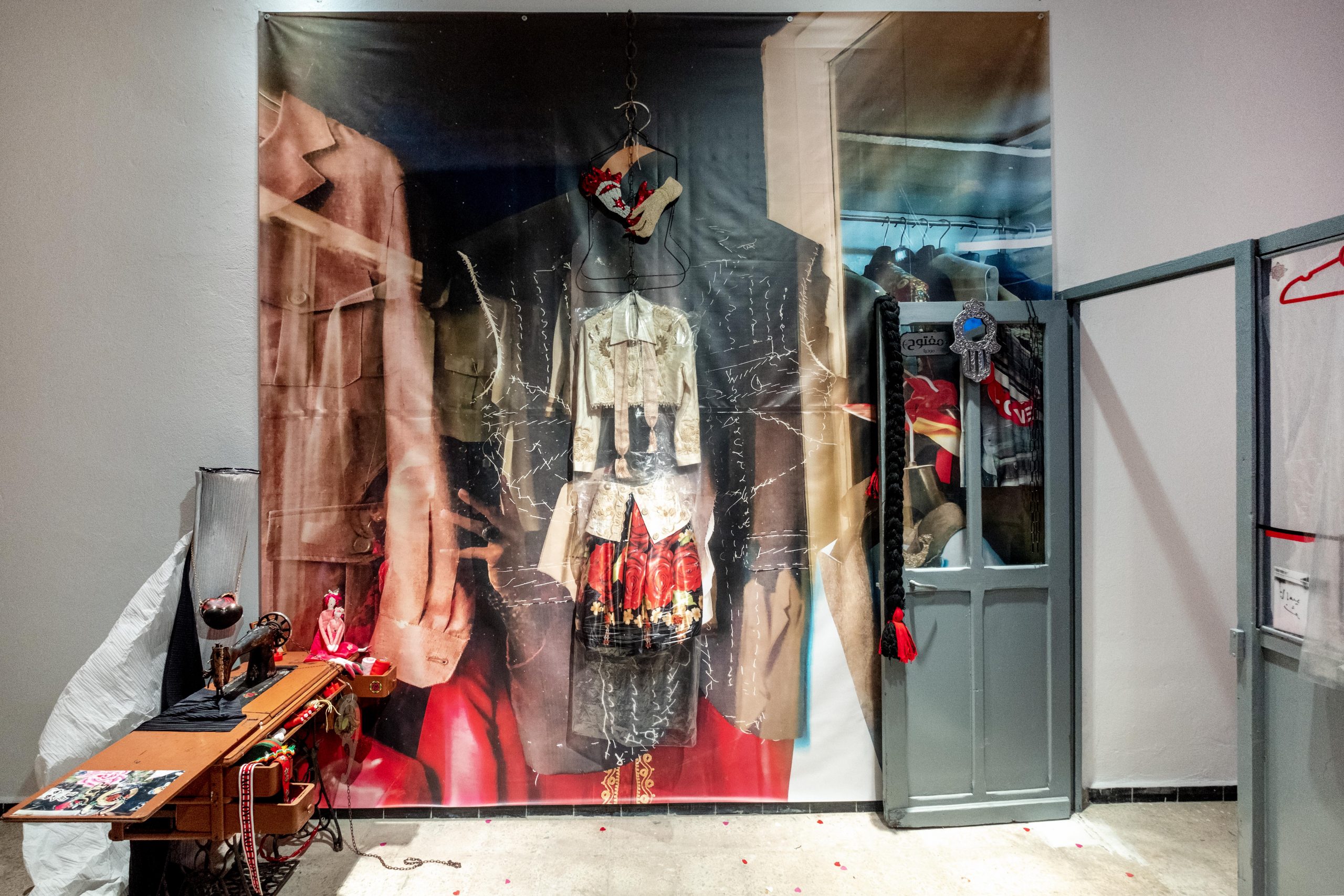
My friend’s story is what comes to mind when I look at Paris-based artist Chalisée Naamani’s work. Born to French and Iranian parents just outside of the capital city, her practice is—superficially, at least—rooted in photography and textiles, specifically clothing. “As a kid,” she once told CFArts, “everyone around me always felt I would become a fashion designer.” But, she continued, “it was too easy, so I didn’t.” Today, Naamani’s artworks are filled with jackets, capes, and dresses, yet her practice isn’t about dressing to suit a specific kind of client (as an atelier would call them), customer (as a clothes store might), or consumer (as market research companies would put it). “There are no bodies in Chalisée Naamani’s work, although everything in her installations bears their mark,” as art critic and Numéro editor Ingrid Luquet-Gad puts it. Rather, unseen bodies appear to haunt her works, acting as stand-ins for the increasingly mobile populations of a globalized world yet calling to mind the restrictions and freedoms that might be placed on them.
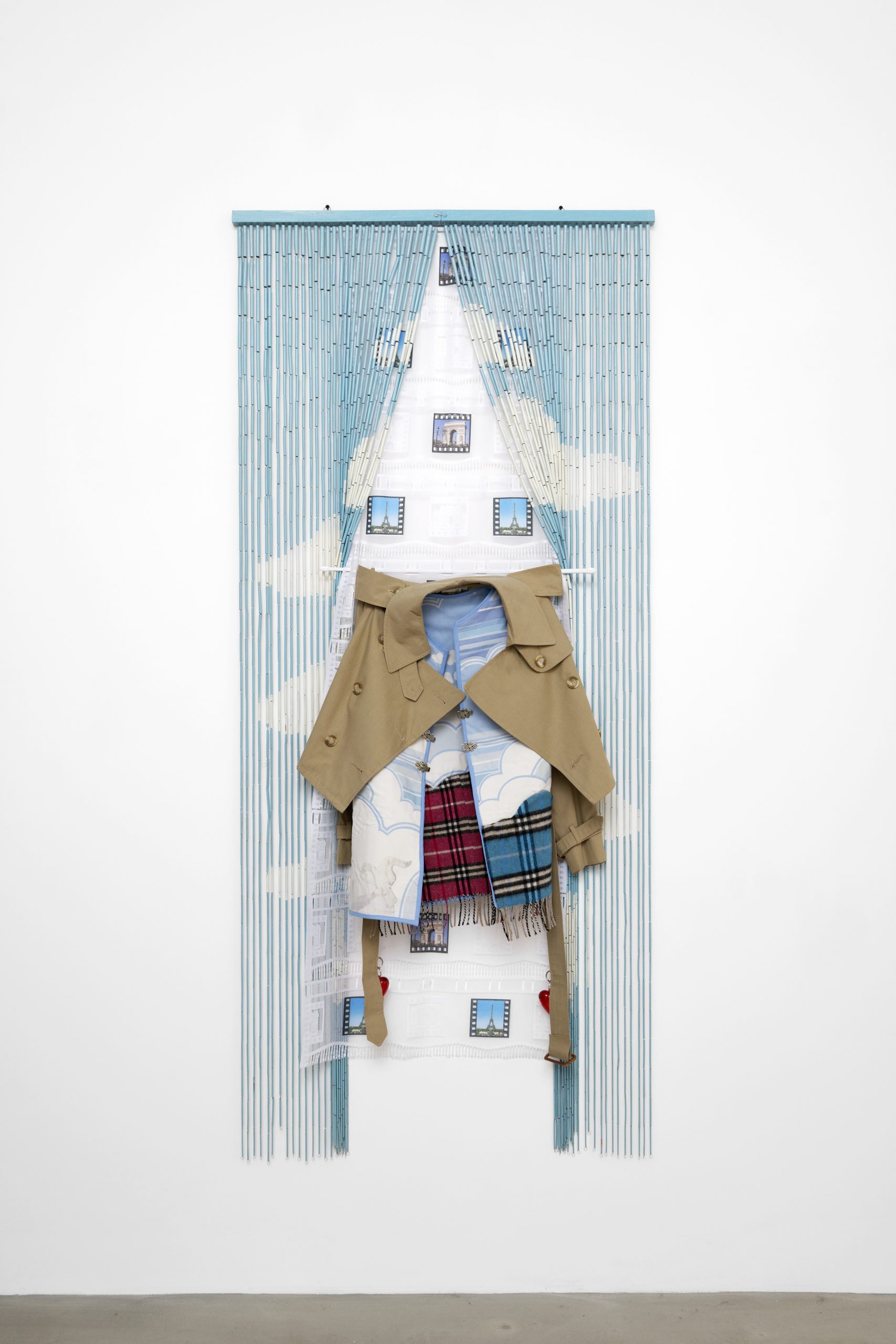
In sculptures, installations, and photographs, Naamani takes symbols, logos, and signifiers out of their usual contexts, confusing and collapsing them into each other. A Pierre Cardin garment bag that her grandfather whisked from Tehran to Paris is paired with a flamenco skirt. Houndstooth boxing gloves dangle from a medieval breastplate. Textures warp and weft; objects become flattened digital images screen-printed onto fabric, or fabric becomes three-dimensionally huge and outsized. In 𝘗𝘰𝘸𝘦𝘳 𝘥𝘳𝘦𝘴𝘴𝘪𝘯𝘨: “𝘞𝘩𝘪𝘭𝘦 𝘭𝘰𝘷𝘦 𝘪𝘴 𝘶𝘯𝘧𝘢𝘴𝘩𝘪𝘰𝘯𝘢𝘣𝘭𝘦, 𝘭𝘦𝘵 𝘶𝘴 𝘭𝘪𝘷𝘦” (𝘈𝘭𝘪𝘤𝘦 𝘞𝘢𝘭𝘬𝘦𝘳) (2022), a smart Dapper Dan-esque red leather suit, with a heart-shaped armless jacket and heart-print lining, dangles from a clothes hanger, complete with bright-yellow oversized interlocking chains made of stuffed fabric that call to mind both the chunkiness of a gold necklace as well as hands clasped in some kind of prayer against violence. Yellow, as Naamani points out in an interview with Le Nouveaux Riches, symbolized wealth and fertility in Greco-Roman antiquity; it was only in the Middle Ages that it came to be associated with hypocrisy and betrayal.
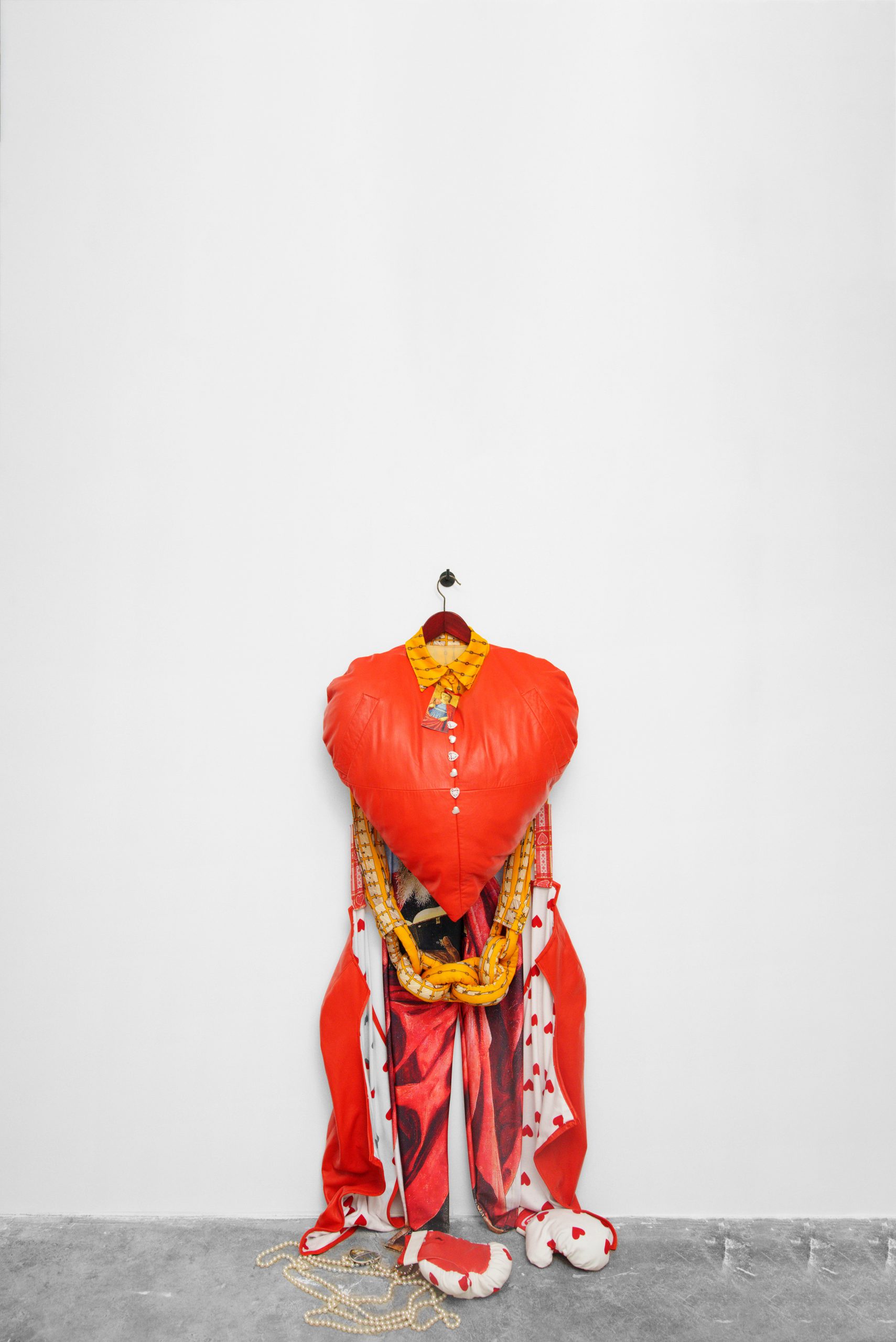
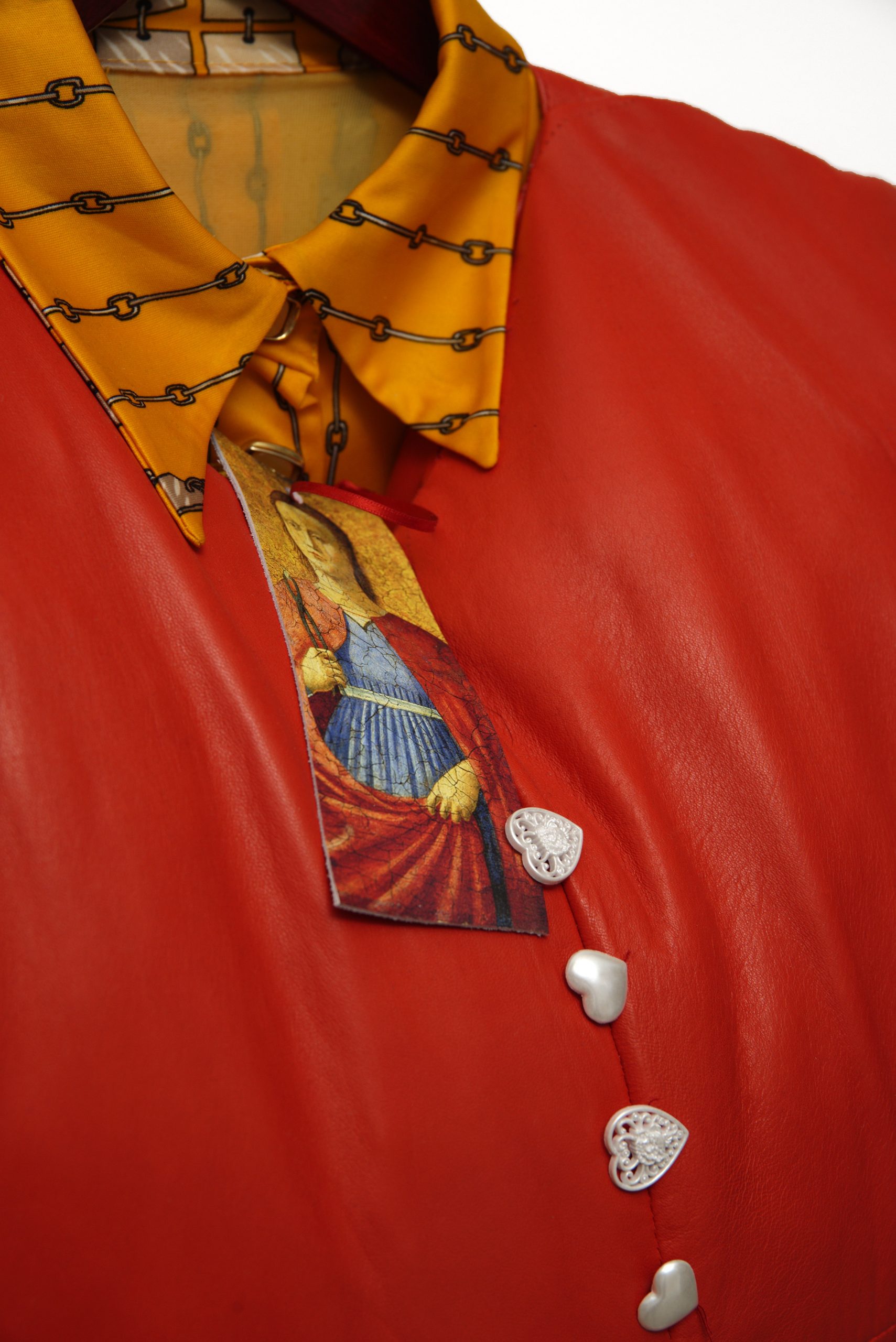
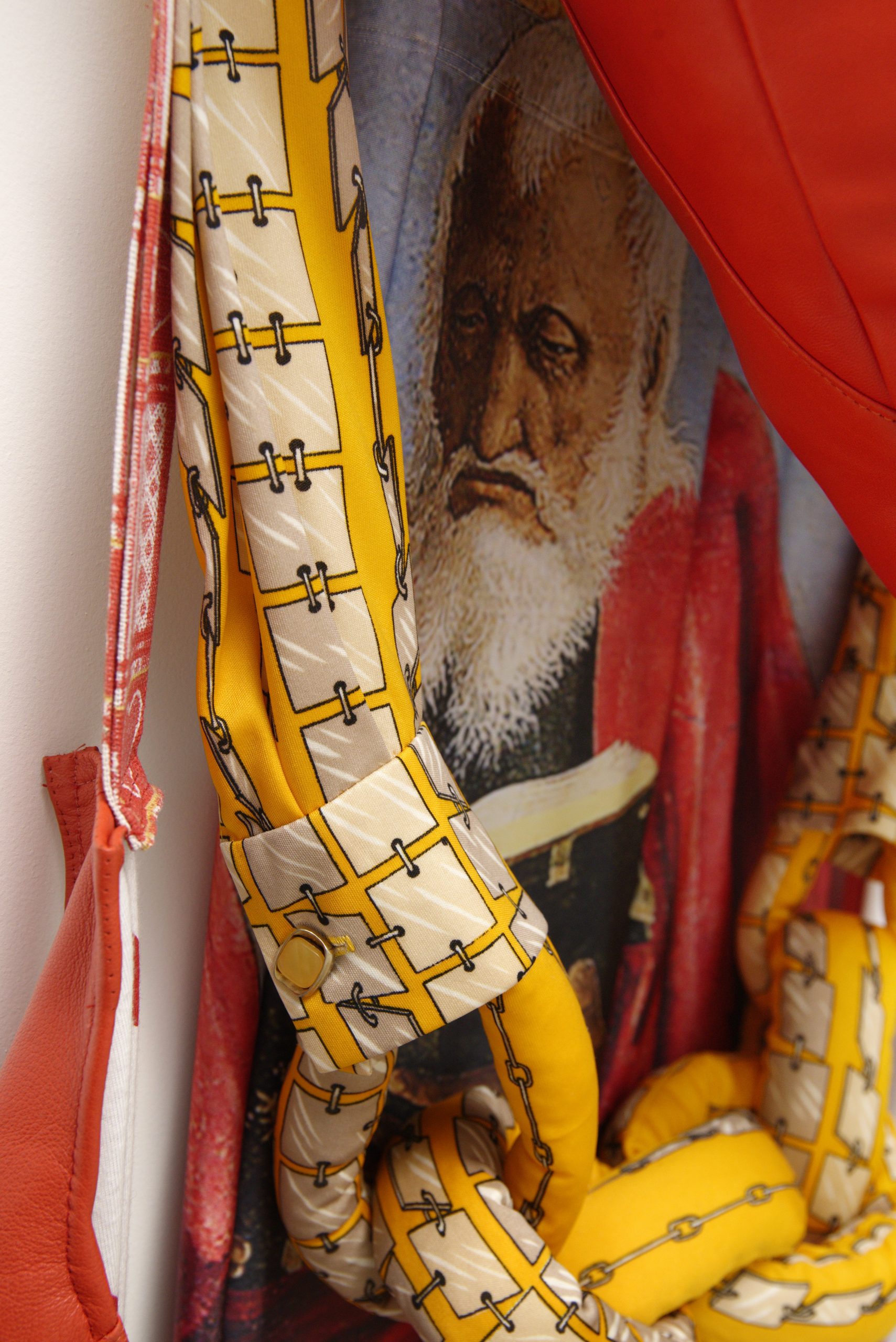
Naamani’s clothes have no strict owners per se, though they do appear to imply the presence of inhabitants. They are hung off clothes rails, hangers, and ladders; sometimes they puddle onto the floor, as if the person wearing them has temporarily vacated the scene or disapparated only to forget to bring their bags with them. These are ghosts with no corporeal form. Like the shoes in an Accra market, we can only grope for the blurry outlines of their former residents. We can guess at who the owner of this suit might be through the alchemy of globalized symbols, put together the way someone short-sighted might form an impression of a person from a distance before they walk into focus. These figures might be Parisian or Persian; certainly, the deftness with which Naamani weaves disparate materials—synthetic silks and suitcases, a Burberry trench here, a fake Birkin bag there, and enough kitsch Paris-themed tchotchkes to choke the Pont des Arts bridge several times over—suggest not a bricolage of assorted junk so much as the Persian rugs of her childhood: layers of intricate, overlapping textures woven together into a seamless whole.
“I grew up with rugs as wall hangings. My relationship to the tableau is really by way of tapestry,” the artist once explained to i-D. “My dad always told me when kings traveled in the desert, they missed flowers and vegetation, and that’s why they wove rugs with floral motifs. Iran is not just carpets or pistachios or saffron, but these references have shaped my gaze,” she continued. “Eventually [rugs also] became a kind of workspace, as I placed images on the rugs to compose them and photograph them.”
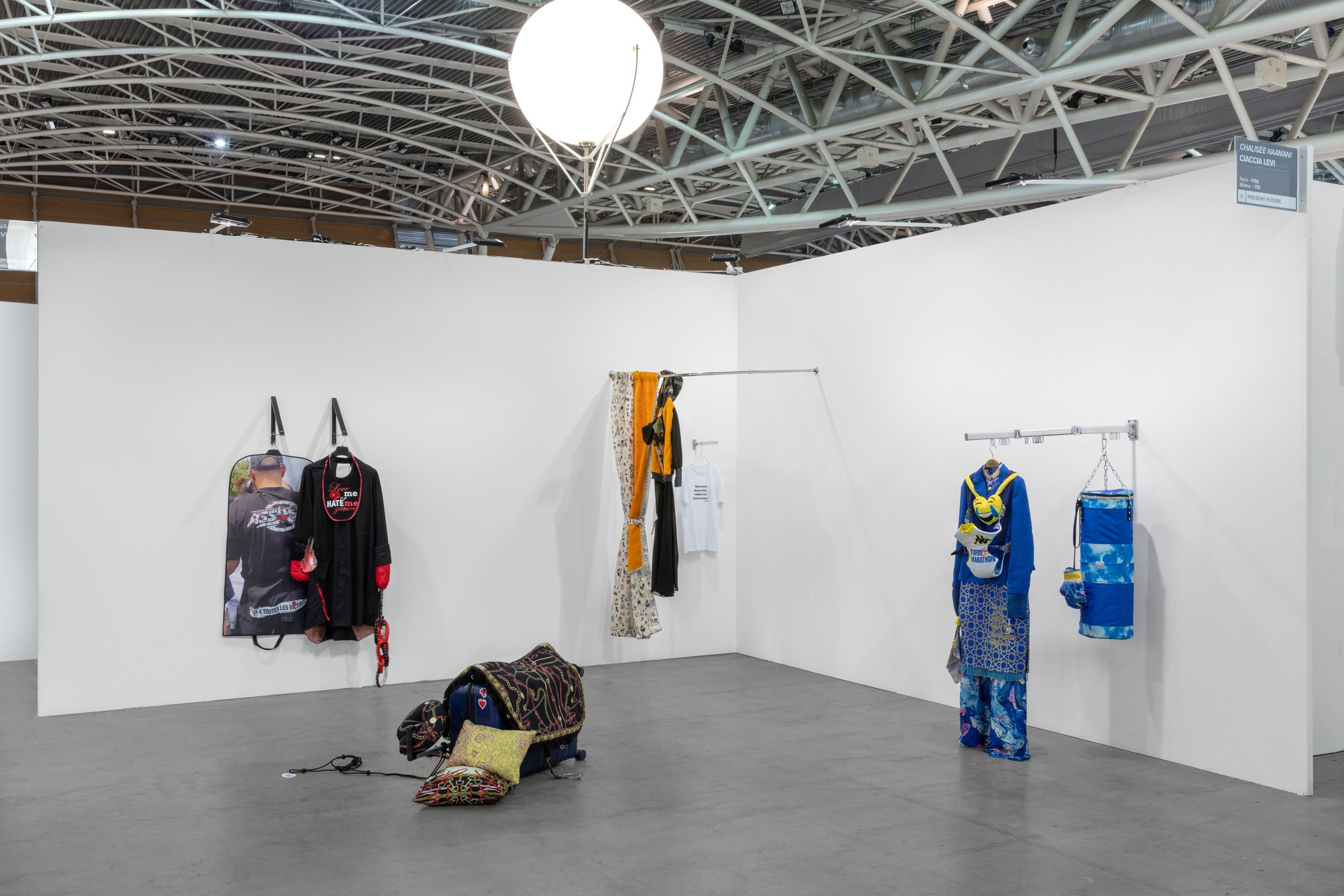
When it comes to fashion, her interest therein is equally layered, speaking to much more than the garments themselves. Naamani grew up with an amour du vêtement, or a love of clothes, and her parents impressed upon her the importance of being dressed well when leaving the house. But loving fashion is not the same thing as loving the multibillion-dollar industry which has come to squat, ogre-like, on preconceptions of what constitutes style: “With the ecological troubles of today, there is a huge responsibility for the fashion industry, which is one of the most polluting on our planet,” she told CFArts. “I take this issue very seriously.”
Indeed, the fashion industry likes to talk up its global credentials. As I write this essay, Chanel, once synonymous with Paris, France, is taking down the Perspex roof of its latest runway show in Manchester, England. The 113-year-old fashion house has previously popped up everywhere from Salzburg, Austria to Dakar, Senegal. What were once “fashion weeks” are now “fashion months” involving a staggering amount of travel. Jet-setting industry insiders can rack up thousands of air miles over the course of a single year, going from New York to Milan to London to Copenhagen; to whatever glamorous location the most monied houses decide to fly a whole coterie of models, stylists, makeup artists, influencers, production staff, designers, and editors.
But, as Naamani says, the implications of this on the climate are profound. Beyond the global jet set, there is the relentless pace of the clothing manufacturing itself (every season coming hot on the heels of the next, not to mention collaborations, one-off drops, and resort collections), which, in turn, reinforces our capacious hunger for new styles. This hunger then shores up the wild excesses of the fast-fashion industry, where low price points are offered in exchange for murky supply chains, labor exploitation, and staggering environmental footprints. In the UK alone, over 7.6 million USD is wasted every year on regrettable fast-fashion purchases. That old adage of “give it to a charity shop!” no longer holds water when donations end up littering the streets and consuming landfills an ocean away.
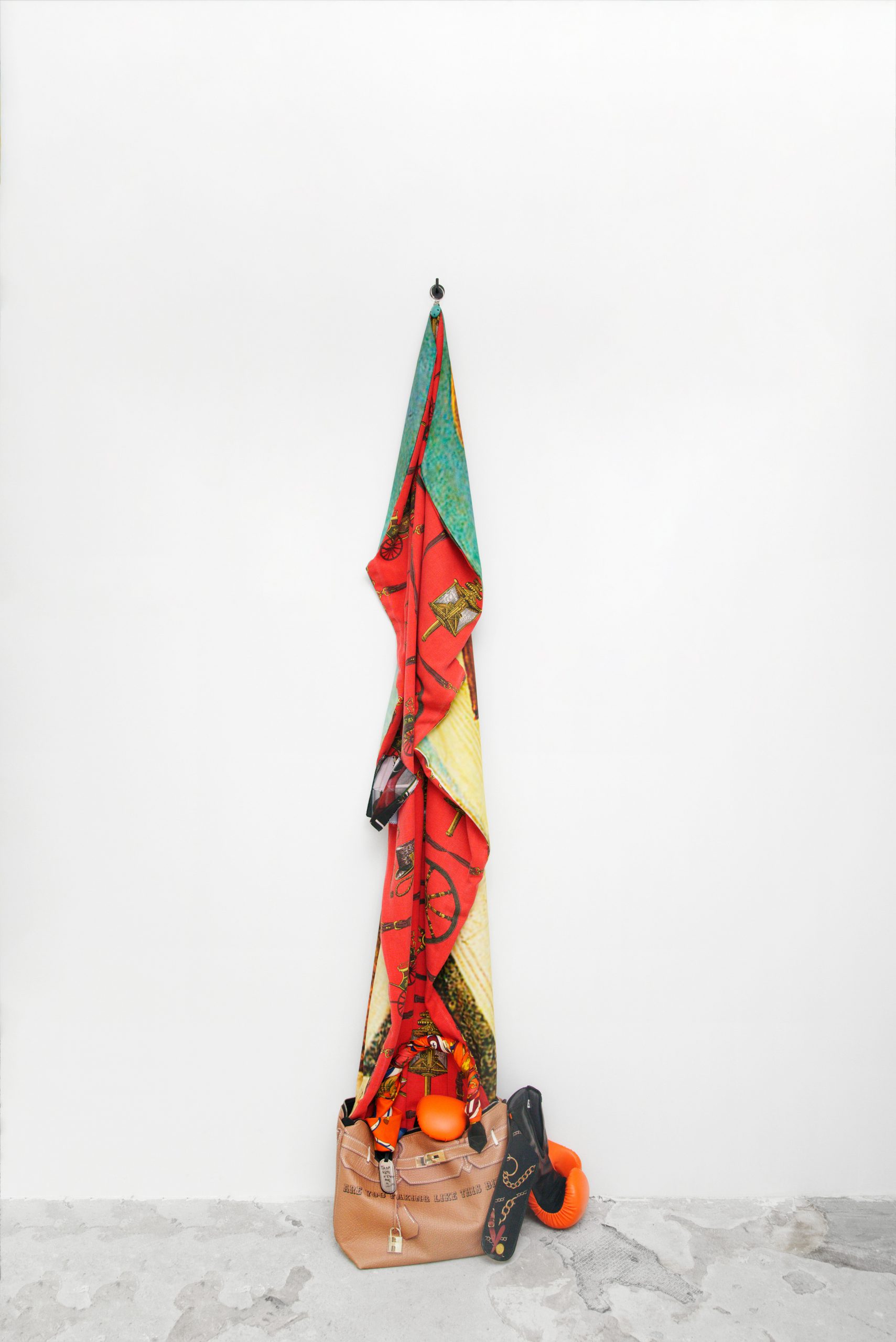
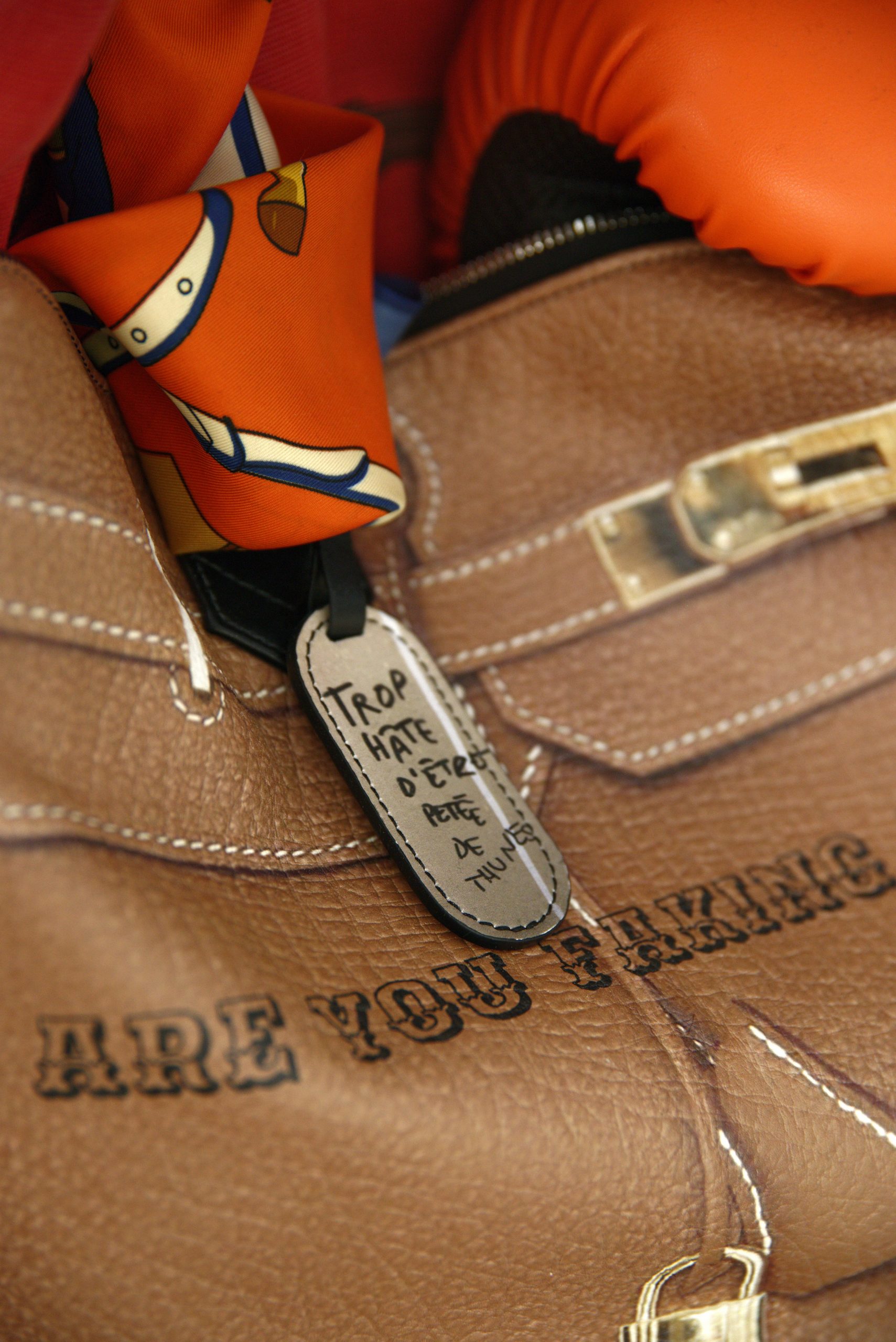
“In the era of fast-fashion and the obsolescence linked to consumption pushed to its climax, I want to offer lasting value to my pieces,” Naamani explained to CFArts. “Textiles are a very powerful memory vector, as strong as photography.”
Naamani’s practice is the result of a hybrid mentality—one in which a sense of style can be cultivated outside the relentless hype cycle, embedded in the twenty-first century and its surroundings in a truly global way; but one which is just as much in discussion with, say, Christian iconography or contemporary political currents like the gilet jaunes movement. Her depth of engagement results in work that doesn’t only reflect the trends of the day but that also probes beyond the immediate zeitgeist to reflect the chaos of this entire century; its overwhelming sea of signs and symbols, crashing on the shores of multiple countries all at once, the way a pair of shoes can travel from the hands of an Indian shoemaker in a factory to the feet of a British customer to a street in Accra.
Zing Tsjeng is an author, journalist, and presenter based in London. Her four-book nonfiction series Forgotten Women was republished in 2023 as an anthology by Brazen.
Banner image: Installation view of Chalisée Naamani, “Quando va male, il leopardo,” Ciaccia Levi, Milan, 2023. Courtesy the artist and Ciaccia Levi, Paris – Milan. Photograph by Sebastiano Pellion Di Persano.
